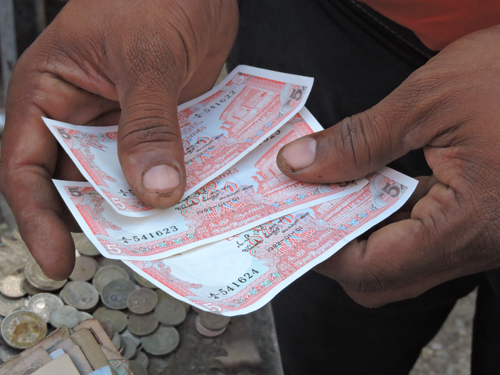Printing money to prosperity!
View(s):
File picture of 5-rupee notes which are no longer in circulation
The global financial crisis in 2008/2009, according to one of the explanations, was caused by a mathematical equation. I know that many would consider this a joke, but it was not so; let me explain to you the story behind it.
It was known as the Black-Scholes equation, developed by two financial economists – Fischer Black and Myron Scholes and published in 1973. The equation revealed a dynamic pricing formula for investors in the derivative market. The equation gradually led to open a whole new world of a booming derivative market for investors. It was a market for “investing on investments” and “gambling on gamblers”.
How did it trigger the financial crisis? When you bundle the investments and sell it to some other investors, you increase your cash flow and profits; then you bundle them and sell it again, again and again; and bundling and selling continues, and eventually the investors and the gamblers become richer and richer. When the others see the gamblers becoming richer and richer, they invest in the gamblers’ assets; and gamblers become even richer.
Everyone in this game was happy as they continued to see themselves becoming wealthier and wealthier. But the problem was that all the wealth that was multiplying was only the ‘numbers’ in the computers. When there were no “real assets” to back the inflating investment bubble, it was going to burst. And it did; the financial market crashed and the wealth evaporated because there was nothing in real terms.
Was it the mathematical equation that misled the world? Or to be precise, should we blame the authors of the equation? Probably yes, but the problem was not with the equation or the authors who produced it. It was, precisely the “ignorance” of the world to ignore “economics” underlying the equation. It is a “world of economics” in which the equation works for the desired profits from investment. And if you keep its underlying economic realities aside and take just the equation out of the context and apply it, here comes the disaster!
Modern money theory (MMT)
I remember the above story for a different reason, which is my theme today. A new idea that has been going around in the recent past tells us “how easy it is for a nation to become rich by just printing money?” It is called the “modern money theory” or MMT, which also originated in the financial market in the US. The MMT became a source of debate since the mid-1990s, while the Google search of it on Internet shows it spiked during the past two years – probably, due to enormous money printing and government spending all over the world without inflation.
What does the MMT say? Governments don’t have to borrow and get into debt crises. They can get their Central Banks to run the money printing machines day-and-night and supply enough money that the government wants to spend. Then the government can build infrastructure (such as roads, railways, power plants, airports and seaports), and spend on public consumption too (such as salaries, public administration, interest payments and welfare).
Why do governments need to tax people, then? Obviously, it is not necessary, if it is for spending purposes. Taxes play a part in the economy to counter-balance government spending in order to avoid over-heating with increased aggregate demand. In fact, budget deficits and resulting public debt burden mean that the government has not taxed the people enough. In other words, a budget deficits mean surplus for the people!
So, what’s the point of struggling so much to achieve progress and prosperity? Print money and begin the development work! If it was such a simple matter, I wonder why the economists from all traditions missed the point for the past 250 years!
Accounting technique
By the way, to our amazement, we have seen that all the money-printing machines have been running over the past decade or so. And they even accelerated during the outbreak of the COVID pandemic. While the rich countries – the US, the UK, the EU and Japan – have printed money in massive amounts, developing countries have also done their part. It was a fertile ground for the MMT idea to prosper and gain momentum, as it did. After seeing the massive increase in money without causing inflation and the overwhelming popularity of the MMT, the world is now confused thinking as to whether money-printing actually works!
Although, the term “money printing” does not refer to the “act of printing currency notes and minting coins”, it is the generally understood term for the act of Central Bank’s “lending” to the Treasury by purchasing government securities. I know that “lending” is not an appropriate term in this context, but it is the case. As a result, however, the Treasury can spend “new money”. If this is true, why not a country produce money as much as the government wants to spend and through that achieve progress and prosperity?
The whole problem is the ignorance of “economics” underlying the practice of this “accounting technique” as in the case of my opening story. Let me elaborate just three points from the “world of economics” to understand whether the MMT works or not in making a country rich.
Booms and busts
The first is that printing money in massive amounts, even though not without limits, can go little too far in rich countries. It is because their currencies are acceptable internationally. US dollars, British pound, Japanese yen and Euro are the most-traded currencies in the world, while these currencies also perform an important role in the world economy as the most-preferred “reserve currencies” to accumulate and store wealth. Therefore, these countries have the ability not only to print more money as they all did, but also to pay for their imports and settle their debt.
 The second point is that think of applying the same principle to a developing country where the currency has no international acceptance. To which extent, does developing countries have the ability to continue with printing more money and avoid all its evil repercussions? To say the least, they cannot import from abroad or pay off their foreign debt or let the currency outflows, unless the local currency is allowed to change into international currency. This means that if a developing country continues with money printing, it is necessary to have controls over foreign exchange outflows in order to defend the exchange rate, which could only be a temporary measure.
The second point is that think of applying the same principle to a developing country where the currency has no international acceptance. To which extent, does developing countries have the ability to continue with printing more money and avoid all its evil repercussions? To say the least, they cannot import from abroad or pay off their foreign debt or let the currency outflows, unless the local currency is allowed to change into international currency. This means that if a developing country continues with money printing, it is necessary to have controls over foreign exchange outflows in order to defend the exchange rate, which could only be a temporary measure.
My third point is even more important: It is about the business cycles in the world. The volume of aggregate economic activities in the world is subject to recurrent booms and busts due to either inherent features of economic change or external causes such as the COVID pandemic. During the boom period, inflationary pressure is mounting so that there is a policy demand for economic stability – cutting down government spending and controlling money stock. During the crisis period, inflationary pressure has subsided due to depressed demand conditions and naturally the policy demand is for increased government spending, financed by money printing. Traditionally, it is known as fiscal and monetary policy stimuli.
Although there is a continuing debate over Keynesianism and Monetarism, it is an instinct outcome that booms call for Monetarist-type policies and crises, Keynesian-type policies. Therefore, the choice of policies is not necessarily about an economic ideological divide, but the “need” of the time we live in.
Wrong discovery
We are now living in a deep crisis time in the world caused by the COVID pandemic issue, but the present crisis began in 2008 with the global financial crisis. As a result, however, there is no inflation either. Because the economies in crisis require fiscal and monetary stimuli, the governments increased spending while the central banks continue to support it with money-printing. And there was room for increased money-printing, more in the rich countries even by pushing the interest rates down to zero level, than in developing countries.
It’s however wrong to detect these changes as moving into MMT. And there will be time again when the world must fix a cap on the blowing money bubble. There will be inflationary pressure again. By that time, there will be a policy reversal too. It will be sooner for developing countries than for rich countries.
(The writer is a Professor of Economics at the University of Colombo and can be reached at
sirimal@econ.cmb.ac.lk and follow on Twitter @SirimalAshoka).



